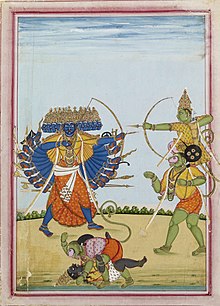
Back રામાયણનાં વિવિધ સંસ્કરણો GU विभिन्न भाषाओं में रामायण HI रामायणाच्या आवृत्त्या MR Versi-versi Ramayana Malay ରାମାୟଣ, ଭିନ୍ନ ଭାଷା ଓ ପ୍ରକାରଭେଦ ରେ OR Phiên bản của sử thi Ramayana VI

Depending on the methods of counting, as many as three hundred[1][2] versions of the Indian Hindu epic poem, the Ramayana, are known to exist. The oldest version is generally recognized to be the Sanskrit version attributed to the Padma Purana - Acharya Shri Raviṣeṇ Padmapurāṇa Ravisena Acharya, later on sage Narada, the Mula Ramayana.[3] Narada passed on the knowledge to Valmiki, who authored Valmiki Ramayana, the present oldest available version of Ramayana.
The Ramayana has spread to many Asian countries outside of India, including Burma, Indonesia, Cambodia, Laos, Philippines, Sri Lanka, Nepal, Thailand, Singapore, Malaysia, Japan, Mongolia, Vietnam and China.[4][5] The original Valmiki version has been adapted or translated into various regional languages, which have often been marked more or less by plot twists and thematic adaptations. Some of the important adaptations of the classic tale include the 12th-century Tamil language Ramavataram, 12th-century Kannada Ramachandra Charitapurana or Pampa Ramayana by Nagachandra, 13th-century Telugu language Sri Ranganatha Ramayanam, 14th-century Assamese Saptakanda Ramayana, 16th-century Awadhi language Ramcharitmanas, 17th-century Malayalam language Adhyathmaramayanam Kilippattu, the Khmer Reamker, the Old Javanese Kakawin Ramayana, and the Thai Ramakien, the Lao Phra Lak Phra Lam, and the Burmese Yama Zatdaw.
The manifestation of the core themes of the original Ramayana is far broader even than can be understood from a consideration of the different languages in which it appears, as its essence has been expressed in a diverse array of regional cultures and artistic mediums. For instance, the Ramayana has been expressed or interpreted in Lkhaon Khmer dance theatre, in the Ramanattam and Kathakali of Kerala, in the Mappila Songs of the Muslims of Kerala and Lakshadweep,[6] in the Indian operatic tradition of Yakshagana, and in the epic paintings still extant on, for instance, the walls of Thailand's Wat Phra Kaew palace temple. In Indonesia, the tales of the Ramayana appear reflected in traditional dance performances such as Sendratari Ramayana and Kecak, masked danced drama, and Wayang shadow puppetry.[7] Angkor Wat in Siem Reap also has mural scenes from the epic Battle of Lanka on one of its outer walls.
- ^ Camille Bulcke, Ramkatha: Utpatti aur Vikās (The Rāma story: Original and development), Prayāg: Hindī Pariṣad Prakāśan, 1950.
- ^ A. K. Ramanujan, "Three hundred Rāmāyaṇas: Five Examples and Three Thoughts on Translation", in Paula Richman (ed.), Many Rāmāyaṇas: The Diversity of a Narrative Tradition in South Asia, Berkeley, California: University of California Press, 1991, p. 48, note 3.
- ^ M. Srinivasachariar (1989). History of Classical Sanskrit Literature: Being an Elaborate Account of All Branches of Classical Sanskrit Literature, with Full Epigraphical and Archaeological Notes and References, an Introduction Dealing with Language, Philology, and Chronology, and Index of Authors & Works. Motilal Banarsidass Publishers. p. 74. ISBN 9788120802841.
- ^ "Ramayana(s) retold in Asia". The Hindu. 19 February 2012. Retrieved 7 February 2015.
- ^ "History of Rama and Ramayan". Hindu Online. 2010. Retrieved 7 February 2015.
- ^ "A different song". The Hindu. 12 August 2005. Archived from the original on 5 January 2007. Retrieved 21 May 2009.
- ^ "Indonesia". Archived from the original on 9 October 2009. Retrieved 13 December 2009.